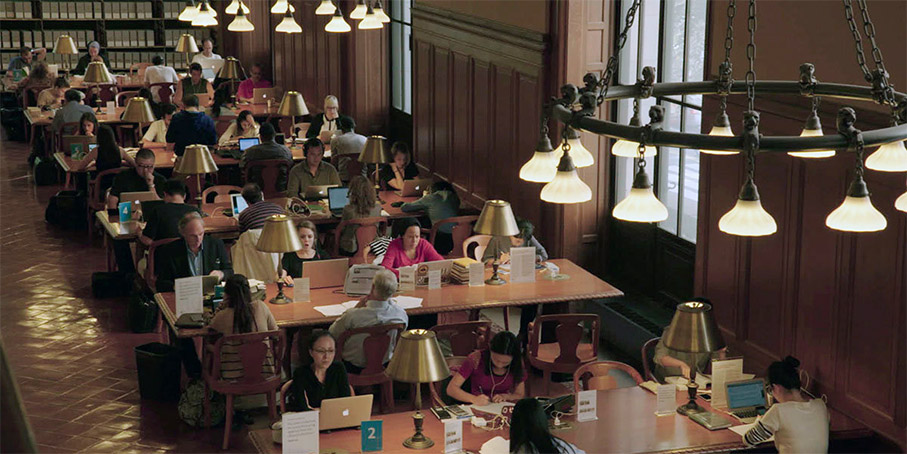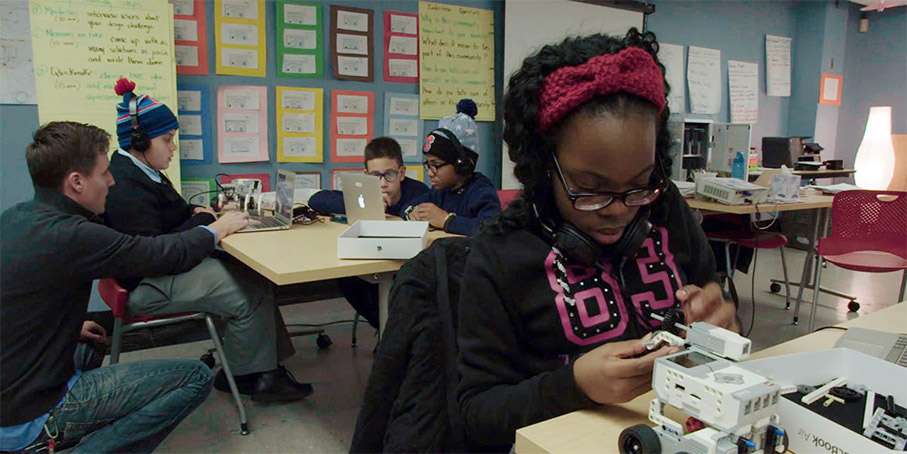| |
"A documentary in the style that I use, if it works, can bring the place to the person – they can feel that they are participant. They can feel that they’re at a staff meeting or at a presentation in the Bronx library. My job as a filmmaker, but particularly as an editor, is to provide the viewer with enough information so they can understand what’s going on and feel that they were an observer at the meeting." |
| |
Director Frederick Wiseman* |
| |
"Whatever the cost of our libraries, the price is cheap compared to that of an ignorant nation." |
| |
Walter Cronkite |
If you enjoy watching friends wince at the idea of sitting down for a film based on little more than prejudicial supposition, try telling them you're about to watch a three-and-a-quarter-hour documentary on the New York Public Library and watch what face they pull. If they are somehow also of the deluded opinion that filmmaking is a young person's game, try adding that the director is a youthful 87 years of age. This shouldn't be an issue, of course, particularly when that director is someone of Frederick Wiseman's extensive experience and skill as a documentary filmmaker.

Wiseman is a genuine master of his craft, a leading light of America's Direct Cinema movement and one of the most revered and respected social documentarians of the past 50 years. Despite his stated detestation of the term, Wiseman is an acute observer, shooting extensively with a canny eye for interesting material and building a detailed and revealing portrait of his subject in the editing room, unaided by captions, narration or interview material. Focussing primarily on institutions (his early films include self-explanatory titles such as High School, Hospital, Basic Training and Juvenile Court), he studies his subjects and then invites us to do likewise and learn about them from what we see and hear rather than what a scripted narration might tell us. A number of his more recent films have hit the three-hour mark (the 2013 At Berkley ran for over 4 hours), but their scope and coverage has always justified this – in this focus on institutions, Wiseman's films feature the character lists as large as you'll find in a Hollywood epic.
The New York Public Library certainly qualifies here, being the second largest public library in America and the fourth largest in the world. Founded in 1895, it now has 88 neighbourhood branches and four scholarly research centres, over 55 million books and other items, and serves over 17 million patrons a year**. With statistics like that, I'm amazed that Wiseman was able to compress the 150 hours of footage he shot into little more than three, and although he focuses primarily on just 13 locations, he covers a huge amount of ground, revealing over the course of the film the remarkable and diverse extent of the services that the library provides. Over the course of the film we drop in on classes in which students are shown how to research the picture archive ("Andy Warhol stole lots of stuff from us," the cheery administrator tells them with just a hint of pride), live poetry readings, music recitals, book groups, lectures, recruitment sessions, social and political discussions, art and photography exhibitions, on-stage interviews with musicians and authors, and a whole lot more. We eavesdrop on staff meetings in which the future and funding of the library is discussed, observe the process of recording an audio book, and watch the consistently patient staff deal with a range of enquiries, including one who politely explains to a caller that unicorns are actually mythical creatures.

There is no overriding narrative here, nor does the film seek to explore the library's history, but instead delivers an absorbing portrait of the institution, the services it offers, those dedicated souls who keep it running and the New Yorkers of various backgrounds and social classes who make use of it and its facilities. It's composed instead of a series of vignettes that rarely connect directly to those that follow or precede it. Many of them play like extracts from longer films on the subjects under observation, but all seem to conclude on a natural pause – never is there the sense that we are cutting away from an activity mid-stream, even though we technically always are. Occasionally – as with the filmed interviews with Elvis Costello, Patti Smith and Richard Dawkins – I found myself aching to see the rest of Wiseman's record of that particular event, though by not allowing any section to overstay its welcome, the sheer variety of material on display really does make that three-hour-plus running time fly by.
In common with so much of Wiseman's work, Ex Libris: New York Public Library proves both enthralling and often educational viewing, and at a time when funding of public institutions is being short-sightedly throttled on both sides of the Atlantic, it also acts as a timely reminder of the important role that libraries play in the community in which they are located. And there is a subtle acknowledgement of the changing nature of information delivery, in the shots of visitors accessing information on computers, tablets and phones, in the distribution of hotspot devices to allow poorer locals to access the internet at home, and in the discussion of the logistical and copyright problems of meeting the increasing demand for titles in e-book form. Perhaps the most surprising illustration of the ever-evolving role of the library, however, is that we never see anyone checking out or returning a book.
Ex Libris: New York Public Library will screen at the 2017 London Film Festival on these dates:
Wednesday 11 October 2017 19:00 – BFI Southbank, NFT1
Saturday 14 October 2017 13:30 – Curzon Mayfair Cinema, Screen 1
|